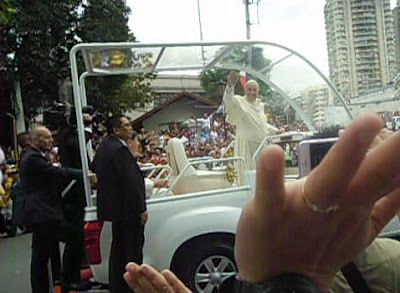On September 23, my friend Kate attended Pope Francis' mass at the Basilica of the National Shrine of Immaculate Conception in Washington DC. She was one of those picked by their Bishop in their parish in Rocklin, Sacramento. From her Facebook posts, she shared how blessed and happy she felt about her encounter with the Pope.
Pope Francis also visited the Philippines in January this year. And it was big! No..it was not big...it was a huge event! The final mass in Manila was attended by 6-7 million people, and is said to be the largest papal event ever.
Pope Francis, endearing as he is, was well received by the Filipinos, who lovingly called him Lolo Kiko (or grandfather Kiko) . It was love at first sight for everyone - there was lots of love given to this very charismatic,fatherly, and very humble man. All throughout his 5 daysvisit in Manila and Tacloban, people lined up the streets, in the airports, in the Papal Nuncio residence, to meet and greet him. People waited for him to arrive, and sent him off waving and smiling, when it was time for him to leave.
The day after he arrived, me and my friend lined up the street outside one of the gates of the Malacanang Palace, where the President holds office. He had a meeting with the President and afterwards, had a motorcade to Manila Cathedral to say a mass. We were there from 5 am, and had a glance of this well loved Pope at around 11am, when his motorcade passed by. The almost 6 hours wait was worth it, the moment I saw him. I was in awe. It was a weird feeling..yes..very much like love at first sight :).
I followed his entire visit through the TV, as probably almost everyone in the Philippines. I listened to each and every homily he did. Despite the language barrier, I remember some of the things he said in his homilies, many are quite practical things.
"Only by becoming poor ourselves, by stripping away our complacency, will we be able to identify with the least of our brothers and sisters. We will see things in a new light..."
"When you lose the capacity to dream, you lose the capacity to love..."
"How many solutions are found to family problems if we take time to reflect?"
"Rest is essential for our health, so that we can hear God's voice and understand what he asks of us..."
But it was his homily during his encounter with the youth at Sto. Tomas University that struck me to the core. And I would forever remember the things that he shared.
“Certain realities of life we only see through eyes cleansed by our tears."
"...using the three languages of the mind, heart and hands – and to use them in harmony. What you think, you feel, and you do. Feel what you think and feel what you do. Do what you think and what you feel. The three languages…To think. To feel. To do. And all in harmony…”
“Real love is about loving and letting yourself be loved."
"To learn how to beg. To learn how to receive with humility. To learn to be evangelized by the poor, by those we help, the sick, orphans, they have so much to give us."
"Reality is superior to ideas"
"We run the risk of becoming museums of young people that have everything but without knowing what to do with them"
I pray that these words will continue to guide me.



















































